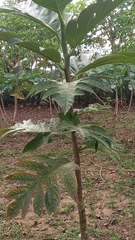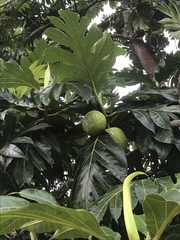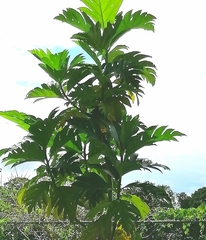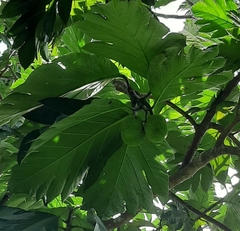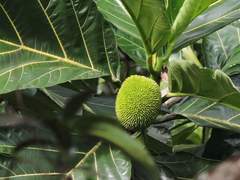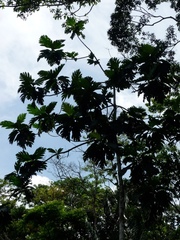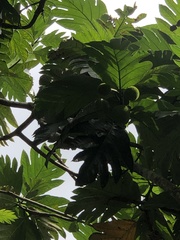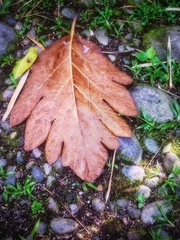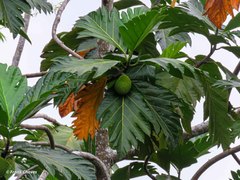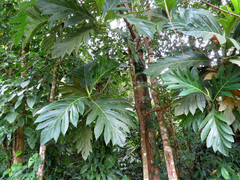

|
Artocarpus communis J. R. Forst. & G. Forst.
 (redirected from: Artocarpus altilis (Parkinson) Fosberg) (redirected from: Artocarpus altilis (Parkinson) Fosberg) |
|
|
Family: Moraceae
Breadfruit, more... (es: árbol de pan, Fruta de pan)
[Artocarpus altilis (Parkinson) Fosberg] |
Descripción: Árbol de 10-30 m de alto. El desprendimiento de cualquier parte de la planta produce el flujo de una savia lechosa. Hojas simples y alternas, de 30-100 x 25-65 cm, con ápice acuminado, bordes lobulados y base aguda a obtusa. Las hojas son escabrosas y ásperas al tacto. Pecíolo de 2-4 cm de largo. Estípulas pares, de 10-25 cm de largo, deciduas, al caer dejan una cicatriz anular en las ramitas. Infrutescencia tipo sincarpo, de 20-30 cm de diámetro. Datos Ecológicos: La especie crece a bajas y medianas elevaciones. El fruta de pan es originario del Sureste Asiático. En Panamá se encuentra como planta cultivada en las provincias de Bocas del Toro, Chiriquí, Colón, Panamá y Veraguas. Florece y fructifica durante todo el año. Especies Parecidas: LK artohe Artocarpus heterophyllus LK2 tiene frutos parecidos, pero en A. heterophyllus las hojas no presentan los bordes lobulados. Usos: La fruta madura se come en dulce o se deja fermentar y se cocina al horno como si fuera pan. Es un alimento energético, ya que contiene almidón, hierro, calcio, fósforo y niacina. En algunas variedades se consumen solamente las semillas, hervidas o tostadas. La savia lechosa es empleada medicinalmente para curar problemas de la piel. Monoecious tree, usually less than 12 (20) m tall; trunk lenticellate; outer bark thin; inner bark thick, granular, with copious milky sap; wood yellowish. Petioles stout, (2) 4-7 cm long; blades ovate in outline, deeply pinnately lobed, acuminate at apices of lobes, the blades acute at base, 30-80 (100) cm long, 15-40 (65) cm wide, thick and leathery, scabrous, usually pubescent below and on veins above; stipules fully amplexicaul, to 15 cm long, conspicuously appressed-pubescent, deciduous. Peduncles stout, 5-8 cm long; staminate spikes club-shaped, 20-40 cm long, ca 3 cm diam at apex, narrower at base, the staminate flowers dense; perianth 2- or 4-lobed, ca 3 mm long; stamen solitary; anther exserted, oblong, bilobed. Distillate flowers in globular or oblong spikes; perianth tubular, embedded in the fleshy rachis; style exserted; stigmas entire, 2- or 3-lobed; fruiting pedicels to 7.5 cm long, 1.5-2 cm wide. Syncarp ellipsoid or rounded, 10-30 cm long, green and soft at maturity, the surface asperous with numerous round or isodiametrical segments or echinate; seeds many. Croat 10121. Bocas Species Database Habitat: The Breadfruit tree can adapt to different habitats. It usually grows in region with an important dry season, but it can grow also in more humid areas. This tree is usually found in equatorial lowlands (below 1500m) and in areas with fairly distributed rainfall. It also needs a well-drained soil. Distribution: Artocarpus altilis is native to Malaysia, Papua New Guinea and the Philippines. It is now introduced and cultivated in various tropical and sub-tropical countries such as Panama, Costa Rica, Colombia and Brazil. It is also present on several islands in the Caribbean, as well as in Southeast Asia and in Australia and New Zealand. Natural History Notes: The breadfruit is native to Malaysia and western Pacific islands. This tree was already cultivated more than 3,000 years ago and would be introduced to new lands as a food supply, as people would transport seedlings in their canoes. The fruit is a good source of carbohydrates, but also of fiber, potassium, calcium and vitamin C. Fruit eating birds and mammals such as bats naturally propagate the breadfruit tree. However, in breadfruit cultures, it is a different story. As the fruits ripe, the seeds are extracted and immediately planted, at about 5 cm of distance between each other and should germinate normally two weeks later. Then, the seedlings are introduced in the field when they are one year old. People also try to propagate the tree vegetatively, cutting roots or stems while the tree is in dormancy. The seedlings are usually planted right at the beginning of the rainy season and once they are settled, they usually require little attention. The tree has a high yield and can produce more than 200 fruits per season. Characteristics: The Breadfruit is an evergreen that can reach a height of up to 20 m and a trunk diameter of 2 m. The leaves are large and have large pinnate lobes (arrangement of multi-divided features). The tree is monoecious, with the presence of both male and female flowers present on the same tree. The male flowers will appear first and thousands of them will be found attached to a spongy core. The female inflorescences consist of up to 2000 little flowers, also attached to a spongy core. Then, the flowers will fuse together to form the edible part of the fruit. The breadfruit varies in size, ranging from 15-60 cm long. It also varies in shape and texture, from smooth to spiny. Finally, the fruit varies in color, from pale green to yellow when mature. There are two varieties of the fruit: one that is seedless and one with a single seed or several small seeds. Notes: The breadfruit has many beneficial uses. It is an important food supply that can be consumed in many different ways: raw, boiled, steamed or roasted. The small, unripe fruit can be pickled and marinated. When the fruit is green, it serves more as a substitute of root vegetables such as potatoes. As it becomes ripe, it is rather cooked with sugar and canella and served as a dessert. The seeds are cooked in salt water. In Polynesia, a fermented breadfruit mash is prepared and is called “masi”. The wood of the breadfruit is fairly light and serves as a candidate of choice to build houses and canoes. Then, the fibrous inner layer of the bark is also used to make cordages. The latex on the fruit and the bark is made into a gum and used to repair canoes but also to cure eye infections and skin irritations caused by fungi. Breadfruits also provide food and shelter for important pollinators or seed dispersers such as honeybees, birds and flying foxes. |







